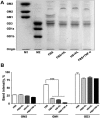Human leukocytes regulate ganglioside expression in cultured micro-pig aortic endothelial cells
- PMID: 23326286
- PMCID: PMC3542384
- DOI: 10.5625/lar.2012.28.4.255
Human leukocytes regulate ganglioside expression in cultured micro-pig aortic endothelial cells
Abstract
Gangliosides are ubiquitous components of the membranes of mammalian cells that are thought to play important roles in various cell functions such as cell-cell interaction, cell adhesion, cell differentiation, growth control, and signaling. However, the role that gangliosides play in the immune rejection response after xenotransplantation is not yet clearly understood. In this study, the regulatory effects of human leukocytes on ganglioside expression in primary cultured micro-pig aortic endothelial cells (PAECs) were investigated. To determine the impact of human leukocytes on the expression of gangliosides in PAECs, we performed high-performance thin layer chromatography (HPTLC) in PAECs incubated with FBS, FBS containing human leukocytes, human serum containing human leukocytes, and FBS containing TNF-α. Both HPTLC and immunohistochemistry analyses revealed that PAECs incubated with FBS predominantly express the gangliosides GM3, GM1, and GD3. However, the expression of GM1 significantly decreased in PAECs incubated for 5 h with TNF-α (10 ng/mL), 10% human serum containing human leukocytes, and 10% FBS containing human leukocytes. Taken together, these results suggest that human leukocytes induced changes in the expression profile of ganglioside GM1 similar to those seen upon treatment of PAECs with TNF-α. This finding may be relevant for designing future therapeutic strategies intended to prolong xenograft survival.
Keywords: Micro-pig aortic endothelial cells; ganglioside GM1; human leukocyte; human serum; tumor necrosis factor-α.
Figures





References
-
- Cozzi E, White DJ. Xenotransplantation. Curr Opin Nephrol Hypertens. 1996;5(6):514–518. - PubMed
-
- Hancock WW. The past, present, and future of renal xenotransplantation. Kidney Int. 1997;51(3):932–944. - PubMed
-
- Parker W, Saadi S, Lin SS, Holzknecht ZE, Bustos M, Platt JL. Transplantation of discordant xenografts: a challenge revisited. Immunol Today. 1996;17(8):373–378. - PubMed
-
- Platt JL. The prospects for xenotransplantation of the kidney. Curr Opin Nephrol Hypertens. 1997;6(3):284–291. - PubMed
-
- Bach FH, Robson SC, Winkler H, Ferran C, Stuhlmeier KM, Wrighton CJ, Hancock WW. Barriers to xenotransplantation. Nat Med. 1995;1(9):869–873. - PubMed

